外研版(2019)必修第二册Unit 6 Earth first Period 1 Starting out & Vocabulary& Listening课件(21张PPT)
文档属性
| 名称 | 外研版(2019)必修第二册Unit 6 Earth first Period 1 Starting out & Vocabulary& Listening课件(21张PPT) |  | |
| 格式 | pptx | ||
| 文件大小 | 82.1MB | ||
| 资源类型 | 教案 | ||
| 版本资源 | 外研版(2019) | ||
| 科目 | 英语 | ||
| 更新时间 | 2022-04-21 08:39:03 | ||
图片预览

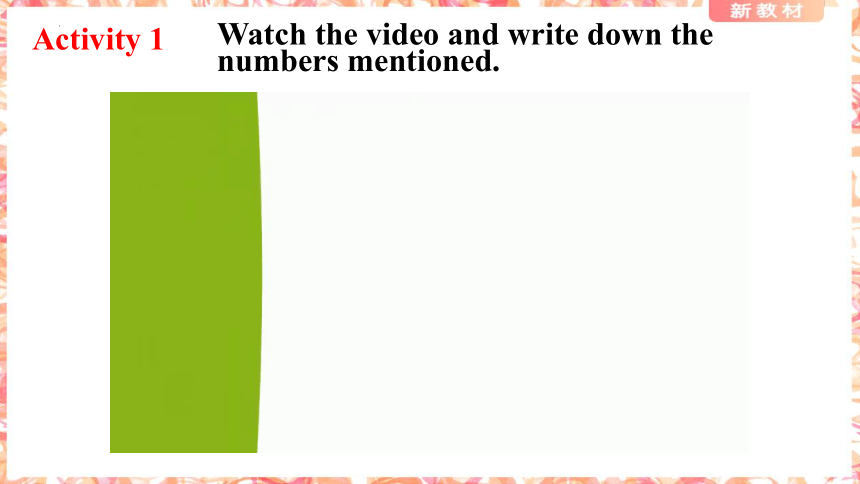
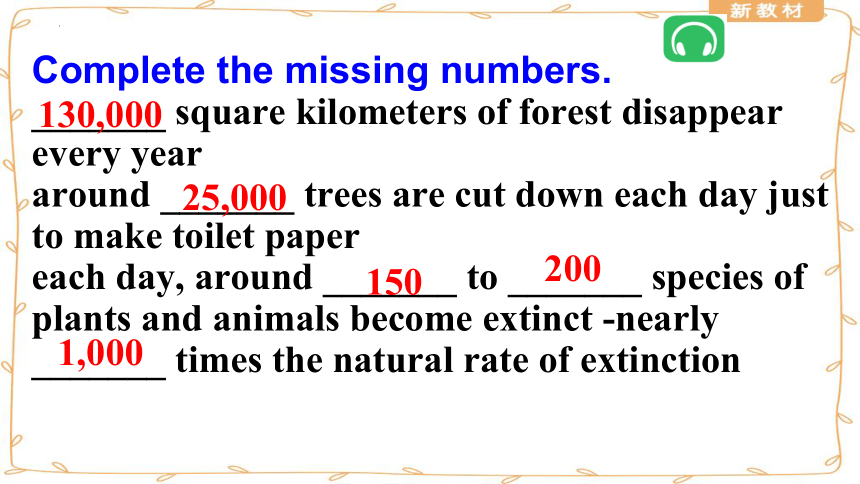

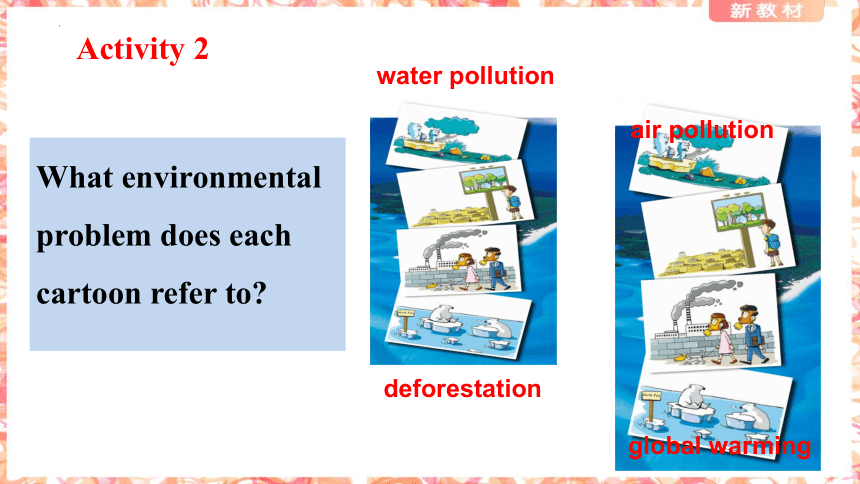

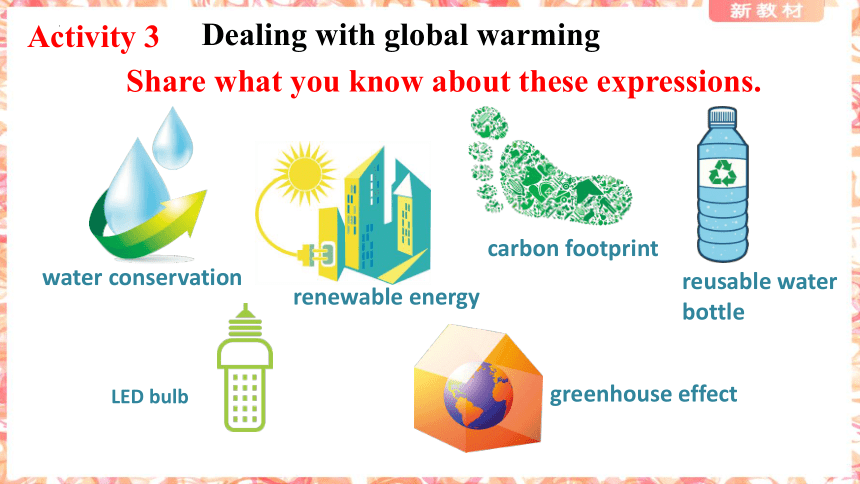
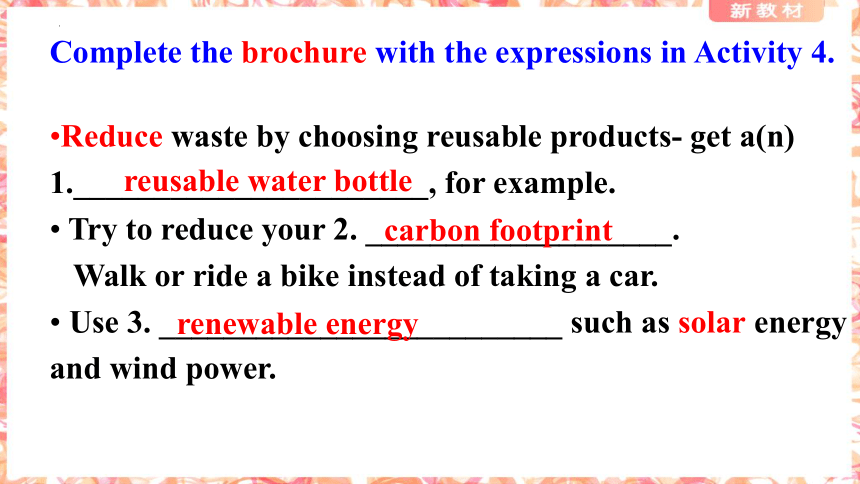

文档简介
(共21张PPT)
Unit 6 Earth first
Period 1
Starting out & Vocabulary& Listening
Activity 1
Watch the video and write down the numbers mentioned.
Complete the missing numbers.
_______ square kilometers of forest disappear every year
around _______ trees are cut down each day just to make toilet paper
each day, around _______ to _______ species of plants and animals become extinct -nearly _______ times the natural rate of extinction
130,000
25,000
150
200
1,000
over ________ animals are killed by ocean pollution each year
_______ people don't have clean drinking water
a plastic bottle can take ______ years to break down
the ice caps are more than ______ thinner than they were ______ years ago
1 million
1 billion
450
50%
40
Activity 2
What environmental problem does each cartoon refer to
water pollution
deforestation
global warming
air pollution
Dealing with global warming
Activity 3
Dealing with global warming
Share what you know about these expressions.
water conservation
renewable energy
LED bulb
carbon footprint
greenhouse effect
reusable water bottle
Complete the brochure with the expressions in Activity 4.
Reduce waste by choosing reusable products- get a(n) 1.______________________, for example.
Try to reduce your 2. ___________________.
Walk or ride a bike instead of taking a car.
Use 3. _________________________ such as solar energy and wind power.
reusable water bottle
carbon footprint
renewable energy
The less energy you use, the less carbon dioxide is released. Replacing a regular light bulb with a(n) 4. __________ is a great start.
5. _________________ is important because clean water is a limited resource. Also, we use a lot of energy to process clean water.
Planting trees can help a lot in reducing the 6. ________________ because trees absorb the carbon dioxide in the air.
LED bulb
Water conservation
greenhouse effect
What is the problem in the picture
smog
Environmental problems to be solved
n.雾
Smog comes from the words “smoke” and “fog”, and it is used to describe the air pollution in cities caused mainly by traffic and factories. Smog can be dangerous because it causes severe breathing problems and infections.
Did you know
Environmental problems to be solved
n.烟雾,雾霾
adj.(问题、伤势、传染病)很严重的
n.感染,传染病
Listen to the lecture and choose the topics that are covered.
What the word “smog” means.
When the word “smog” appeared.
What caused smog in the past.
What causes smog now.
The effects of smog on the environment.
How governments try to reduce smog.
What will happen if we don’t reduce smog.
Activity 4
Listen again and complete the slides.
Smog in the past
Term created in: _______
Big problem in London:
________________ in December 1952
Causes of the problem: burning too much
coal and ___________
1900s
The Great Smog
no wind
Activity 5
Smog in the present
Causes of the problem:
___________________________
Measures: rules about using __________ in factories and ______________________ _________ in the city centre.
chemicals coming from traffic
chemicals
requirements of paying to
drive
Why do we have to protect the earth
What measures should we take to protect the earth
听力原文
Lecturer: Good evening, everyone, and thank you for coming to today’s talk. I’m Dr Brown and I’m going to talk about air pollution in cities- what we all know as “smog”. Please feel free to stop me if you have any questions. So, first of all, a bit of history. The term “smog” was first used in the 1800s in cities that had problems with smoke and fog.
Student A: Sorry for interrupting, but I believe
it was in the 1900s.
Lecturer: Sorry, I made a mistake. You are
right. It was in the 1900s. Thank you. London
was one of the cities where smog caused big
problems. In December 1952, it suffered from
“The Great Smog”. It was a very cold winter, so
a lot of coal was burned at home and in the
factories. The problem was that there was no
wind, so thick smog covered the city. Nowadays…
打扰,打断
Student B: Excuse me, but can I just ask- did the
smog cause any deaths
Lecturer: I’m afraid so. According to research,
about 4,000 people are known to have died as a
result of the smog, but that number could be
much higher. It was terrible! Nowadays, smog
still exists, but is produced by chemicals coming
from traffic and factories. However, governments
are taking measures to reduce smog as much as
possible. Now, let’s look at what smog does to our
health…
采取措施
Student A: If I could just stop you again… Can
you give us examples of these measures
Lecturer: Well, for example, factories must
follow rules about what chemicals they use. In
some cities, when there’s smog, people have to
pay to drive in the centre. Now, let’s move on to
the impact of smog on our health…
Please preview the passage in P62 and do the exercises in P64.
Unit 6 Earth first
Period 1
Starting out & Vocabulary& Listening
Activity 1
Watch the video and write down the numbers mentioned.
Complete the missing numbers.
_______ square kilometers of forest disappear every year
around _______ trees are cut down each day just to make toilet paper
each day, around _______ to _______ species of plants and animals become extinct -nearly _______ times the natural rate of extinction
130,000
25,000
150
200
1,000
over ________ animals are killed by ocean pollution each year
_______ people don't have clean drinking water
a plastic bottle can take ______ years to break down
the ice caps are more than ______ thinner than they were ______ years ago
1 million
1 billion
450
50%
40
Activity 2
What environmental problem does each cartoon refer to
water pollution
deforestation
global warming
air pollution
Dealing with global warming
Activity 3
Dealing with global warming
Share what you know about these expressions.
water conservation
renewable energy
LED bulb
carbon footprint
greenhouse effect
reusable water bottle
Complete the brochure with the expressions in Activity 4.
Reduce waste by choosing reusable products- get a(n) 1.______________________, for example.
Try to reduce your 2. ___________________.
Walk or ride a bike instead of taking a car.
Use 3. _________________________ such as solar energy and wind power.
reusable water bottle
carbon footprint
renewable energy
The less energy you use, the less carbon dioxide is released. Replacing a regular light bulb with a(n) 4. __________ is a great start.
5. _________________ is important because clean water is a limited resource. Also, we use a lot of energy to process clean water.
Planting trees can help a lot in reducing the 6. ________________ because trees absorb the carbon dioxide in the air.
LED bulb
Water conservation
greenhouse effect
What is the problem in the picture
smog
Environmental problems to be solved
n.雾
Smog comes from the words “smoke” and “fog”, and it is used to describe the air pollution in cities caused mainly by traffic and factories. Smog can be dangerous because it causes severe breathing problems and infections.
Did you know
Environmental problems to be solved
n.烟雾,雾霾
adj.(问题、伤势、传染病)很严重的
n.感染,传染病
Listen to the lecture and choose the topics that are covered.
What the word “smog” means.
When the word “smog” appeared.
What caused smog in the past.
What causes smog now.
The effects of smog on the environment.
How governments try to reduce smog.
What will happen if we don’t reduce smog.
Activity 4
Listen again and complete the slides.
Smog in the past
Term created in: _______
Big problem in London:
________________ in December 1952
Causes of the problem: burning too much
coal and ___________
1900s
The Great Smog
no wind
Activity 5
Smog in the present
Causes of the problem:
___________________________
Measures: rules about using __________ in factories and ______________________ _________ in the city centre.
chemicals coming from traffic
chemicals
requirements of paying to
drive
Why do we have to protect the earth
What measures should we take to protect the earth
听力原文
Lecturer: Good evening, everyone, and thank you for coming to today’s talk. I’m Dr Brown and I’m going to talk about air pollution in cities- what we all know as “smog”. Please feel free to stop me if you have any questions. So, first of all, a bit of history. The term “smog” was first used in the 1800s in cities that had problems with smoke and fog.
Student A: Sorry for interrupting, but I believe
it was in the 1900s.
Lecturer: Sorry, I made a mistake. You are
right. It was in the 1900s. Thank you. London
was one of the cities where smog caused big
problems. In December 1952, it suffered from
“The Great Smog”. It was a very cold winter, so
a lot of coal was burned at home and in the
factories. The problem was that there was no
wind, so thick smog covered the city. Nowadays…
打扰,打断
Student B: Excuse me, but can I just ask- did the
smog cause any deaths
Lecturer: I’m afraid so. According to research,
about 4,000 people are known to have died as a
result of the smog, but that number could be
much higher. It was terrible! Nowadays, smog
still exists, but is produced by chemicals coming
from traffic and factories. However, governments
are taking measures to reduce smog as much as
possible. Now, let’s look at what smog does to our
health…
采取措施
Student A: If I could just stop you again… Can
you give us examples of these measures
Lecturer: Well, for example, factories must
follow rules about what chemicals they use. In
some cities, when there’s smog, people have to
pay to drive in the centre. Now, let’s move on to
the impact of smog on our health…
Please preview the passage in P62 and do the exercises in P64.
